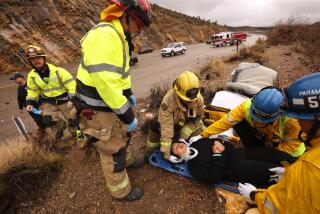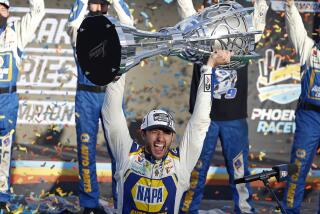He Starts Off Where the Road Ends : Whether Racing Through the Desert or Searching for a Lost Boy, Ashley Is Strictly Business
The parched and foreboding desert outside Barstow has been good to David Ashley, an off-road racer from Riverside who also is an active volunteer member of the San Bernardino County Sheriffâs Department search and rescue team.
Ashley, 35, has nine class victories in the Fireworks 250, an annual July 4 desert race that starts and ends near Barstow. He has won four times in a desert buggy and five times--including the last three years--in a four-wheel-drive truck. Ashley also won the first California 400 on a motorcycle in a Barstow-area race.
Saturday, driving a Ford F-150 truck for auto dealer Dick Landfieldâs Enduro Racing team, he will be going for his fourth consecutive Fireworks 250 victory in the fourth event of the six-race High Desert Racing Assn.âs U.S.A. Cup series. Ashley, who won the Nissan 400 and the SCORE-sanctioned San Felipe 250 earlier this season, is defending series champion in the Class 4 division for long wheelbase 4x4s.
The Barstow area is also where Ashley received wilderness-tracking training from the U.S. Border Patrol to help him in searching for missing persons in the mountains and deserts of San Bernardino County.
âIâd had a lot of experience tracking animals while hunting, so it wasnât all that difficult,â Ashley said. âHumans are animals, too. They just leave different types of tracks.â
Ashley played an important role in the search for 12-year-old Jared Negrete, the Boy Scout from El Monte who was lost last July 19 and never found on the rocky slopes of 11,500-foot San Gorgonio Mountain. After a searcher found the boyâs camera and the film inside was developed, Ashley was assigned to find the spot where each of the 13 pictures was taken.
âThe camera was found about 40 yards off the main trail between Forest Falls and the summit of San Gorgonio, at about 10,400 feet elevation,â Ashley said. âThe boy was then about a half-mile from where his group had last seen him. By using a view finder exactly like the one in his camera, I was able to locate where he stood, or knelt, to take each picture. I could even pinpoint the time of day by the shadows and other markings.
âMost of the pictures were scenic, although some were shots of his group before he became separated. I started by backtracking from the spot where the camera was found. The photo sites were spread out over about a 2 1/2-mile stretch that we hoped would give us an indication in what direction he was headed.
âAt night, I went in with dogs. . . . The dogs pick up the scent better when itâs cool, and at night there arenât so many distractions from other searchers. It was almost impossible to get everywhere we wanted because of the steep terrain. The shale and rocks made footing extremely treacherous, almost impossible, at times.â
Although the case was formally closed Aug. 4, when the sheriffâs office dismantled its Angelus Oaks command post after as many as 2,000 searchers had spent nearly three weeks looking for the lost youth, Ashley continues to search for a clue that might lead to something.
âI guess you could say itâs an obsession with me,â he said. âIâm going to spend a week in August going over all of the terrain again. Maybe something will turn up, like a piece of his clothing or the blue canteen he had that has never been found. Itâs possible that the runoff from melting snow could dislodge some evidence that the searchers missed the first time. Iâm not convinced that heâs still in the mountains, but Iâm not willing to give up. To me, itâs still an open case.â
To prepare himself for the search, Ashley immersed himself in the Scoutâs background, studying his habits at home, at school and with his family. He discovered in a book report the boy had written that he had learned to bury himself at night, covering his body with leaves in order to keep warm.
âOne of the most important things trackers must do is to learn to think like the person they are trying to find,â he said.
Although searchers failed to find Negrete, Ashley has a high percentage of success in other searches.
âLast Thanksgiving weekend, a woman, 34, and a boy, 13, got separated from a family excursion while trying to scale Mt. Baldy,â Ashley said. âThe weather turned very bad with a wind about 50 m.p.h. and a chill factor of minus 20 degrees, at least. The two carried minimal cold weather clothing, only a light (jacket) for what was supposed to be a fun family outing.
âLuckily, they found shelter out of the wind and spent the better part of the night on the Lytle Creek side of Mt. Baldy, the steep side. We found them the next day, cold and scared, but alive with only minor injuries. At times like that, I marvel at how resilient people are in times of crisis.â
Ashley credits an upbringing in the outdoors for his affinities for both racing and rescuing.
âI was born in Riverside and lived there until my teens, when we moved to Evansville, Ind., and then moved back to Riverside a few years later. That way, I got the best of both outdoors worlds. I started riding a motorcycle in Baja and learned desert survival with my dad when I was 11. And then when we moved to Indiana, I rode in the woods and learned to ride when it was wet and muddy.â
When Ashley was 18, he became the youngest rider ever to earn a berth on the U.S. team in the International Six-Day Trials. In 1976, he won an ISDT gold medal, riding a Yamaha in Austria.
In 1978, the Ashley family moved back to Riverside and David decided to switch from motorcycles to cars in off-road racing.
âI figured it wouldnât be too hard after riding cycles all my life, but it wasnât that easy,â he said. âI raced buggies for an independent team, but I never had enough backing to be more than the second driver on the team.
âI got my big break when Dick Landfield retired as a racer and hired me to drive his truck. Iâve been with him ever since. It was kind of funny, winding up with Landfield, because when I was 13 I was involved with one of his sons when he was hurt riding in Mexico. He and his brother had crashed, and when I rode up on them, one of them had a broken ankle and his face beat up.
âI rode into camp for help and found Dick and rode him double back to where the boys were. I probably gave him the ride of his life. It was about 10 to 15 miles and, needless to say, we were in a hurry.
âThen, 15 years later, I started to race for him.â
Despite his desert racing success, one of Ashleyâs most memorable moments occurred in the Coliseum in 1987, when he drove a Jeep as a replacement for Al Unser Jr. and won the Mickey Thompson Off-Road Gran Prix.
âJeep had signed up Little Al to make a stadium driver out of him, and Landfield assigned me the job of helping him,â Ashley said. âI tested his truck when he had other engagements and when he had (an Indy car) race in the Meadowlands (N.J.) the weekend of the Coliseum race, I drove his Jeep and led all 10 laps. I managed to hold on, but not before everybody else in the race took a shot at me.â
Ashley raced intermittently in stadium events for a couple of years until he joined the BF Goodrich Rough Riders to concentrate on racing desert trucks prepared by Landfield.
âI donât really see much correlation between racing and tracking, except for the intensity both require,â he said.
âThere is the same sense of urgency in racing to win as there is in the challenge of man vs. terrain.â
More to Read
Sign up for Essential California
The most important California stories and recommendations in your inbox every morning.
You may occasionally receive promotional content from the Los Angeles Times.










